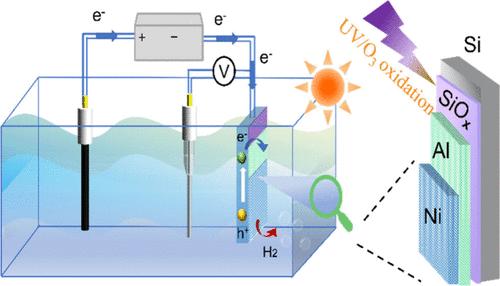SiOx Interfacial Engineering of UV/Ozone Oxidation for an Efficient Water-Reduction Metal–Insulator–Semiconductor Silicon Photocathode
IF 11.3
1区 化学
Q1 CHEMISTRY, PHYSICAL
引用次数: 0
Abstract
A metal–insulator–semiconductor (MIS) structure is an attractive interfacial structure for efficient photoelectrochemical (PEC) water-splitting reactions. However, developing a cost-effective and highly active photoelectrode for the PEC water-splitting reaction is still a major challenge. In this study, we use an easy-to-operate and economical UV/ozone (UV/O3) oxidation process to prepare ultrathin SiOx oxide as an insulating layer, which is integrated with the bilayer non-precious-metal collector Al/Ni serving as the catalyst and the p-Si semiconductor to obtain a cost-effective and efficient MIS structure photocathode. The outcomes demonstrate that the ultrathin SiOx insulation layer significantly improves the PEC hydrogen evolution reaction (HER), through comparing the photovoltage and photocurrent density of the MIS system. The inner metal Al in the bilayer collector Al/Ni regulates the degree of band bending at the semiconductor–metal interface. Additionally, the presence of the ultrathin Al2O3 insulation layer effectively reduces Fermi-level pinning, which promotes the efficient transfer of photoelectrons to electrolytes. These were confirmed through photoelectric performance testing of the MIS system. The generation of a photocurrent of 15 mA cm–2 at a potential level of 0 V (vs reversible hydrogen electrode) has been obtained by optimizing the thickness of the SiOx and bilayer non-precious-metal collector. This study presents an economical and efficient strategy for enhancing PEC-HER performance in silicon-based photocathodes using an MIS structure.

SiOx 紫外线/臭氧氧化界面工程用于高效还原水金属-绝缘体-半导体硅光电阴极
金属-绝缘体-半导体(MIS)结构是一种极具吸引力的界面结构,可用于高效的光电化学(PEC)分水反应。然而,开发用于 PEC 水分离反应的高性价比、高活性光电极仍是一项重大挑战。在本研究中,我们采用易于操作且经济的紫外/臭氧(UV/O3)氧化工艺制备了超薄氧化硅作为绝缘层,并将其与作为催化剂的双层非贵金属集流体铝/镍和对硅半导体结合在一起,从而获得了一种经济高效的 MIS 结构光电阴极。研究结果表明,通过比较 MIS 系统的光电压和光电流密度,超薄氧化硅绝缘层显著改善了 PEC 氢进化反应(HER)。双层收集器 Al/Ni 中的内层金属 Al 可调节半导体-金属界面的带弯曲程度。此外,超薄 Al2O3 绝缘层的存在有效降低了费米级钉销,从而促进了光电子向电解质的有效转移。对 MIS 系统进行的光电性能测试证实了这一点。通过优化氧化硅和双层非贵金属集电层的厚度,在 0 V 电位水平(相对于可逆氢电极)下可产生 15 mA cm-2 的光电流。这项研究提出了一种利用 MIS 结构提高硅基光电阴极 PEC-HER 性能的经济、高效的策略。
本文章由计算机程序翻译,如有差异,请以英文原文为准。
求助全文
约1分钟内获得全文
求助全文
来源期刊

ACS Catalysis
CHEMISTRY, PHYSICAL-
CiteScore
20.80
自引率
6.20%
发文量
1253
审稿时长
1.5 months
期刊介绍:
ACS Catalysis is an esteemed journal that publishes original research in the fields of heterogeneous catalysis, molecular catalysis, and biocatalysis. It offers broad coverage across diverse areas such as life sciences, organometallics and synthesis, photochemistry and electrochemistry, drug discovery and synthesis, materials science, environmental protection, polymer discovery and synthesis, and energy and fuels.
The scope of the journal is to showcase innovative work in various aspects of catalysis. This includes new reactions and novel synthetic approaches utilizing known catalysts, the discovery or modification of new catalysts, elucidation of catalytic mechanisms through cutting-edge investigations, practical enhancements of existing processes, as well as conceptual advances in the field. Contributions to ACS Catalysis can encompass both experimental and theoretical research focused on catalytic molecules, macromolecules, and materials that exhibit catalytic turnover.
 求助内容:
求助内容: 应助结果提醒方式:
应助结果提醒方式:


